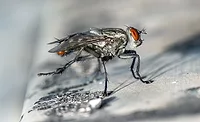PFAS in Food Packaging: What You Need To Know
FDA's and EPA's regulation of PFAS is developing, and it is an important consideration for food producers and packagers

Image credit: SimonSkafar/iStock/Getty Images Plus via Getty Images
Per- and polyfluoroalkyl substances (PFAS) have garnered growing attention in recent years due to concerns about their widespread presence and potential health risks. Also called "forever chemicals," PFAS include an extensive and diverse group of thousands of synthetic compounds that resist grease, oil, water, heat, and stains. They also resist breaking down in the environment. These characteristics make PFAS compounds popular as food contact materials, but they also lead to their accumulation in soil, water, and living organisms.
PFAS gained attention relatively recently, but they have been produced commercially since the 1940s. Developed and touted for their unique properties, PFAS have applications in various industries, including non-stick cookware, food packaging, water-repellent fabrics, stain-resistant carpeting, and firefighting foams. Some compounds, such as Teflon (PTFE) and perfluorooctanoic acid (PFOA), became ubiquitous in consumer products. Consistent with pervasive use, PFAS have been found in soil, drinking water, and wildlife.
By the late 1990s and early 2000s, scientific research began to identify that PFAS do not break down readily in our bodies or the environment, so their concentration builds up over time. Studies link PFAS to serious health issues, including cancer, liver damage, thyroid disease, and reproductive problems. These findings prompted regulatory scrutiny by multiple agencies. The U.S. Environmental Protection Agency (EPA) is the lead regulator in the U.S. addressing PFAS in soil and water. Among other efforts, EPA has designated two widely used PFAS—PFOA and PFOS—as hazardous substances under the Comprehensive Environmental Response, Compensation, and Liability Act. EPA also issued a national drinking water standard for PFAS. The U.S. Food and Drug Administration (FDA) has primary regulatory responsibility for the safety of food, food packaging, and related consumer products containing PFAS.
FDA Actions Regarding PFAS in Food Packaging
FDA's current regulatory framework specifically addresses PFAS only in limited contexts. Food Contact Substances Notifications (FCNs) require manufacturers to notify FDA when introducing new food contact substances, including those containing PFAS. FDA reviews these submissions to ensure they meet safety standards and has authorized several FCNs containing PFAS.
Since the 1960s, FDA has authorized specific types of substances that contain PFAS for food contact applications. The authorized uses for PFAS generally fall into four categories:
- Non-stick cookware: PFAS may be used as a coating to make cookware non-stick
- Sealing gaskets for food processing equipment: PFAS may be used as a resin in forming certain parts used in food processing equipment that require chemical and physical durability
- Manufacturing aids: PFAS may be used as processing aids for manufacturing other food contact polymers to reduce buildup on manufacturing equipment
- Paper/paperboard food packaging: PFAS may be used as grease-proofing agents in fast food wrappers, microwave popcorn bags, take-out paperboard containers, and pet food bags to prevent food oil and grease from leaking through the packaging.
Current data available to FDA indicates that only paper and paperboard food packaging with PFAS is likely to cause a potential safety concern. FDA announced in February 2024 that grease-proofing substances containing PFAS are no longer being sold by manufacturers for food contact use in the U.S. This development is not a regulatory requirement; rather, it is a result of voluntary commitments by industry to stop the sale of grease-proofing substances containing certain types of PFAS that FDA has concluded carry health risks. The voluntary market phase-out eliminates these substances from food packaging paper and paperboard, the major sources of dietary exposure to PFAS from food packaging. At present, there is no regulatory enforcement mechanism for the use of these PFAS compounds in food packaging, but FDA is working on an analytical method to monitor the market for PFAS in food packaging.
Even though manufacturers of these particular PFAS agreed to stop selling them for food packaging in the U.S., their customers are likely to have existing stock for some time. Those businesses may continue to distribute or use the products they already have. The FCNs for these short-chain PFAS food contact substances remain in effect.
FDA's announcement does not affect short-chain PFAS food contact substances with effective FCNs for uses other than as grease-proofing agents on paper and paperboard food packaging. For example, FCNs authorize certain PFAS substances in non-stick pots and pans and food processing equipment.
Looking for quick answers on food safety topics?
Try Ask FSM, our new smart AI search tool.
Ask FSM →
State Laws Banning PFAS in Food
In addition to federal developments, several states are working to restrict PFAS in food distribution and packaging. California, Colorado, Connecticut, Hawaii, Maryland, Maine, Minnesota, Rhode Island, Vermont, Virginia, and Washington already have passed laws prohibiting the use of PFAS as a processing agent.
In New York, ECL § 37-0203 restricts the use of PFAS in pails, trays, wrappers, bags, and tubs, and in paper plates, cups, and bowls sold to retailers. The New York law addresses only PFAS intentionally added rather than the incidental presence of PFAS in food packaging. Even so, the New York State Department of Environmental Conservation (NYDEC) encourages manufacturers to avoid incidental uses of PFAS. The effort by NYDEC may signal future requirements in New York prohibiting PFAS in food packaging, regardless of intent.
What to Expect Going Forward
Regulation of PFAS compounds is a developing area, including in food packaging. Recent studies and agency actions are a start to protecting consumers from the risks of certain PFAS compounds, but what can we expect going forward?
We can expect changes in PFAS regulation by EPA and FDA as more information becomes available and with the new administration in Washington. Even if EPA and FDA do not impose further PFAS restrictions, litigation trends suggest that food producers and packagers can expect more creative litigation related to the risks of potential PFAS exposure from food packaging:
Plaintiffs are using new and inventive ways to pursue litigation of FDA-regulated product manufacturers, such as economic injuries from failure to advise consumers of the presence of PFAS.
- Plaintiffs are citing federal statutes regarding food labeling in claims that the presence of PFAS renders food misbranded. However, any misbranding issues still require proof that there was a level of PFAS exposure in the product that could cause harm.
- Food litigation is primarily centered on the migration theory.
PFAS litigation is progressing quickly. For example, although there have been substantial updates to the Food, Drug and Cosmetic Act ("FD&C Act") regarding reporting and labeling for cosmetic manufacturers, they only require FDA to assess PFAS use and safety in the coming years. As a result, regulations cited in litigation often are environmental or involve statutes drafted without consideration for PFAS.
Considering the lack of reliable scientific evidence regarding the level of PFAS exposure necessary to cause injury, plaintiffs advocate for a zero-tolerance standard for PFAS content. Complaints routinely have cited EPA's 2023 proposals regarding drinking water, where EPA proposed a Maximum Contaminant Level ("MCL") of 4.0 parts per trillion (ppt) for PFOA and PFOS, with a health-based, non-enforceable MCL goal of zero.
Plaintiffs also cite analogous federal and state statutes regarding food labeling to claim that incidental PFAS in a food makes it misbranded or adulterated under FD&C Act § 342, which prohibits false or misleading labeling. Even so, the FD&C Act defines an adulterated product as one that "contains any poisonous or deleterious substance which may render it injurious to health," per 21 U.S.C. § 342(a)(1). It seems, then, that any misbranding claim related to PFAS under the FD&C Act requires proof of the level of PFAS necessary to cause harm. That scientific debate can be challenging and expensive for both sides in litigation, as the cases below illustrate.
Recent PFAS Litigation Related to Food Packaging
In Winans v. Ornua Foods North America, Inc., No. 2:23-cv-01198-FB-RML, 2024 WL 1741079 (E.D.N.Y. Apr. 23, 2024), the plaintiff sued related to the presence of PFAS in Kerrygold butter. In 2023, New York passed a state law banning PFAS in food packaging. Defendant Ornua recalled all Kerrygold butter because its packaging contained PFAS. Plaintiff's claims included: (i) deceptive business acts or practices, (ii) false advertising, (iii) selling adulterated or misbranded food, (iv) negligence per se; and (v) unjust enrichment. Winans sought both money damages and injunctive relief.
The Court trimmed the case, claiming the labeling and marketing of Pure Irish Butter as "pure" was false or misleading because it contained PFAS alleged to have migrated from the packaging. The Court found a reasonable consumer reading the label could conclude that the word "pure" indicates the absence of contaminants like PFAS but dismissed the injunctive relief claim because plaintiff was unlikely to be injured in the future from the alleged mislabeling.
In Hernandez v. Wonderful Company LLC, No. 23-cv-1242, 2023 WL 9022844 (S.D.N.Y. Dec. 29, 2023), plaintiff claimed she purchased and consumed POM products purported to be 100 percent natural juice products but containing unsafe levels of PFAS. The complaint alleged violations of the Magnuson-Moss Warranty Act, breach of express warranty, negligence per se, unjust enrichment, and violations of New York's Deceptive Trade Practices Act and Agriculture and Markets Law. The Court held that plaintiff failed to include details about the nature or results of the independent testing she conducted on the products and did not plausibly allege that substantially all of the product contained PFAS. The court allowed the plaintiff to amend her complaint.
In Richburg v. Conagra Brands, Inc., No. 22 CV 2420, 2023 WL 1818561 (N.D. Ill. Feb. 8, 2023), plaintiffs brought a class action against Conagra Brands Inc., owner of Orville Redenbacher's popcorn products and Angie's BOOMCHICKAPOP. The complaint alleged that Conagra falsely and misleadingly marketed popcorn products when it used microwave bags that contained significant levels of PFAS while claiming the products used "natural" and "real" ingredients. The Court granted Conagra's motion to dismiss, holding, "in light of the FDA's exemption of migratory substances from the mandated list of 'ingredients' on food product packaging…, the representation on the packaging is correct as a matter of law."
Conclusion
FDA's and EPA's regulation of PFAS is developing, and it is an important consideration for food producers and packagers. Even without new regulations, FDA has taken some important steps to limit the risk of exposure to PFAS from food packaging. As research continues and we learn more about the risks associated with these substances, it is anticipated that FDA will face pressure to develop more regulations and guidance. Even without regulatory expansion, food producers and packagers should be wary of litigation trends showing creative efforts to craft and pursue claims associated with exposure to PFAS in food packaging.
Elizabeth (Beth) Davis, J.D., is a Partner and Co-Chair of the Environmental Practice Group at Arnall Golden Gregory LLP. She is also a member of the firm's Healthcare practice and Life Sciences industry team, serving clients across a broad spectrum of industries, including chemical companies, real estate developers, retailers, lenders, drug and medical device manufacturers, and more.








